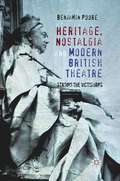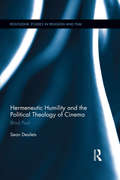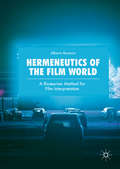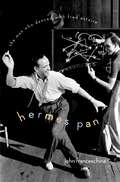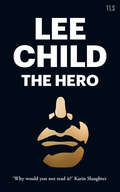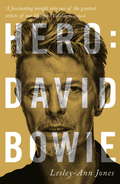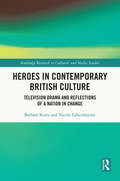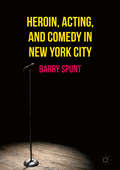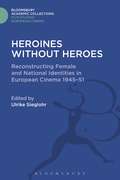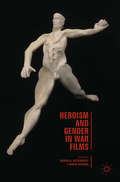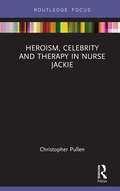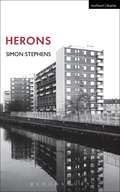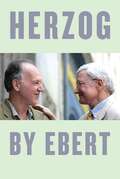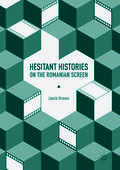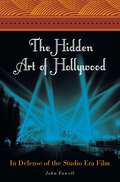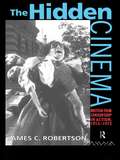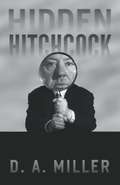- Table View
- List View
Heritage, Nostalgia and Modern British Theatre: Staging the Victorians
by Benjamin PooreThe stage portrayal of the Victorians in recent times is a key reference point in understanding notions of Britishness, and the profound politicisation of that debate over the last four decades. This book throws new light on works by canonical playwrights like Bond, Edgar, and Churchill, linking theatre to the wider culture at large.
Hermeneutic Humility and the Political Theology of Cinema: Blind Paul (Routledge Studies in Religion and Film)
by Sean DesiletsThis book revisits the tradition of Western religious cinema in light of scholarship on St. Paul’s political theology. The book’s subtitle derives from the account in the Book of Acts that St. Paul was temporarily blinded in the wake of his conversion on the road to Damascus. In imitation of Paul, the films on which Sean Desilets’s analysis hinges (including those of Carl-Th. Dreyer, Robert Bresson, Pier Paolo Pasolini, and Carlos Reygadas) place a god-blind mechanism, the camera, between themselves and the divine. Desilets calls the posture they adopt "hermeneutic humility": hermeneutic in that it interprets the world, but humble in that it pays particular—even obsessive—attention to its own limits. Though these films may not consciously reflect Pauline theology, Desilets argues that they participate in a messianic-hermeneutic tradition that runs from Paul through St. Augustine, Blaise Pascal, Karl Barth, and Walter Benjamin, and which contributes significantly to contemporary discussions in poststructuralist literary theory, political theology, and religious studies. Desilets’s insightful explication of Jean-Luc Nancy’s deconstruction of Christianity and Georgio Agamben’s recent work on religion makes a substantial contribution to film philosophy and emerging critical trends in the study of religion and film. This book puts forward a nuanced theoretical framework that will be useful for film scholars, students of contemporary political theology, and scholars interested in the intersections of religion and media.
Hermeneutic Humility and the Political Theology of Cinema: Blind Paul (Routledge Studies in Religion and Film)
by Sean DesiletsThis book revisits the tradition of Western religious cinema in light of scholarship on St. Paul’s political theology. The book’s subtitle derives from the account in the Book of Acts that St. Paul was temporarily blinded in the wake of his conversion on the road to Damascus. In imitation of Paul, the films on which Sean Desilets’s analysis hinges (including those of Carl-Th. Dreyer, Robert Bresson, Pier Paolo Pasolini, and Carlos Reygadas) place a god-blind mechanism, the camera, between themselves and the divine. Desilets calls the posture they adopt "hermeneutic humility": hermeneutic in that it interprets the world, but humble in that it pays particular—even obsessive—attention to its own limits. Though these films may not consciously reflect Pauline theology, Desilets argues that they participate in a messianic-hermeneutic tradition that runs from Paul through St. Augustine, Blaise Pascal, Karl Barth, and Walter Benjamin, and which contributes significantly to contemporary discussions in poststructuralist literary theory, political theology, and religious studies. Desilets’s insightful explication of Jean-Luc Nancy’s deconstruction of Christianity and Georgio Agamben’s recent work on religion makes a substantial contribution to film philosophy and emerging critical trends in the study of religion and film. This book puts forward a nuanced theoretical framework that will be useful for film scholars, students of contemporary political theology, and scholars interested in the intersections of religion and media.
Hermeneutics of the Film World: A Ricœurian Method for Film Interpretation
by Alberto BaraccoThis book identifies a new methodological strategy for the interpretation of film philosophizing. Many recent works in film philosophy, adopting the approach identified with the term film as philosophy, have considered film as capable of doing philosophy. Focused on the basic relationship between film and filmgoer, the proposed method is founded on the concept of the film world. Combining Merleau-Ponty’s and Ricœur’s philosophies, and reconsidering Goodman’s theory of worldmaking, the film world becomes the hermeneutic horizon from which film philosophical thought can emerge. The book shows how Ricœurian methodology has the potential to provide a valuable resource for film studies by inviting scholars to consider film interpretation in terms of film world hermeneutics.
Hermeneutics of the Film World: A Ricœurian Method for Film Interpretation
by Alberto BaraccoThis book identifies a new methodological strategy for the interpretation of film philosophizing. Many recent works in film philosophy, adopting the approach identified with the term film as philosophy, have considered film as capable of doing philosophy. Focused on the basic relationship between film and filmgoer, the proposed method is founded on the concept of the film world. Combining Merleau-Ponty’s and Ricœur’s philosophies, and reconsidering Goodman’s theory of worldmaking, the film world becomes the hermeneutic horizon from which film philosophical thought can emerge. The book shows how Ricœurian methodology has the potential to provide a valuable resource for film studies by inviting scholars to consider film interpretation in terms of film world hermeneutics.
Hermes Pan: The Man Who Danced with Fred Astaire
by John FranceschinaArmed with an eighth-grade education, an inexhaustible imagination, and an innate talent for dancing, Hermes Pan (1909-1990) was a boy from Tennessee who became the most prolific, popular, and memorable choreographer of the glory days of the Hollywood musical. While he may be most well-known for the Fred Astaire-Ginger Rogers musicals which he choreographed at RKO film studios, he also created dances at Twentieth Century-Fox, M-G-M, Paramount, and later for television, winning both the Oscar and the Emmy for best choreography. In Hermes Pan: The Man Who Danced with Fred Astaire, Pan emerges as a man in full, an artist inseparable from his works. He was a choreographer deeply interested in his dancers' personalities, and his dances became his way of embracing and understanding the outside world. Though his time in a Trappist monastery proved to him that he was more suited to choreography than to life as a monk, Pan remained a deeply devout Roman Catholic throughout his creative life, a person firmly convinced of the powers of prayer. While he was rarely to be seen without several beautiful women at his side, it was no secret that Pan was homosexual and even had a life partner. As Pan worked at the nexus of the cinema industry's creative circles during the golden age of the film musical, this book traces not only Pan's personal life but also the history of the Hollywood musical itself. It is a study of Pan, who emerges here as a benevolent perfectionist, and equally of the stars, composers, and directors with whom he worked, from Astaire and Rogers to Betty Grable, Rita Hayworth, Elizabeth Taylor, Sammy Davis Jr., Frank Sinatra, Bob Fosse, George Gershwin, Samuel Goldwyn, and countless other luminaries of American popular entertainment. Author John Franceschina bases his telling of Pan's life on extensive first-hand research into Pan's unpublished correspondence and his own interviews. Pan enjoyed one of the most illustrious careers of any Hollywood dance director, and because his work also spanned across Broadway and television, this book will appeal to readers interested in musical theater history, dance history, and film.
Hermes Pan: The Man Who Danced with Fred Astaire
by John FranceschinaArmed with an eighth-grade education, an inexhaustible imagination, and an innate talent for dancing, Hermes Pan (1909-1990) was a boy from Tennessee who became the most prolific, popular, and memorable choreographer of the glory days of the Hollywood musical. While he may be most well-known for the Fred Astaire-Ginger Rogers musicals which he choreographed at RKO film studios, he also created dances at Twentieth Century-Fox, M-G-M, Paramount, and later for television, winning both the Oscar and the Emmy for best choreography. In Hermes Pan: The Man Who Danced with Fred Astaire, Pan emerges as a man in full, an artist inseparable from his works. He was a choreographer deeply interested in his dancers' personalities, and his dances became his way of embracing and understanding the outside world. Though his time in a Trappist monastery proved to him that he was more suited to choreography than to life as a monk, Pan remained a deeply devout Roman Catholic throughout his creative life, a person firmly convinced of the powers of prayer. While he was rarely to be seen without several beautiful women at his side, it was no secret that Pan was homosexual and even had a life partner. As Pan worked at the nexus of the cinema industry's creative circles during the golden age of the film musical, this book traces not only Pan's personal life but also the history of the Hollywood musical itself. It is a study of Pan, who emerges here as a benevolent perfectionist, and equally of the stars, composers, and directors with whom he worked, from Astaire and Rogers to Betty Grable, Rita Hayworth, Elizabeth Taylor, Sammy Davis Jr., Frank Sinatra, Bob Fosse, George Gershwin, Samuel Goldwyn, and countless other luminaries of American popular entertainment. Author John Franceschina bases his telling of Pan's life on extensive first-hand research into Pan's unpublished correspondence and his own interviews. Pan enjoyed one of the most illustrious careers of any Hollywood dance director, and because his work also spanned across Broadway and television, this book will appeal to readers interested in musical theater history, dance history, and film.
The Hero
by Lee ChildWHAT MAKES A HERO? WHO BETTER TO ANSWER THAT QUESTION THAN LEE CHILD… ‘It’s Lee Child. Why would you not read it?’ Karin Slaughter ‘I don't know another author so skilled at making me turn the page’ The Times
Hero: David Bowie
by Lesley-Ann Jones'Through interviews with friends and colleagues, as well as detailed research, the writer has gained unprecedented knowledge of the true story behind the legend. This is a fascinating insight into one of the greatest artists of our lifetime.' Evening Standard'Through several interviews with Bowie she evocatively portrays his fascinating life, often with a tenderness you wouldn't expect.' Daily Express'An intriguing book. This is a personal friendship in writing. The knowledge divulged here is an endearing and powerful tale of a man who conquered the entire entertainment industry with his creative force.' VarietyA unique portrait of the globally revered artist and the extraordinary, complex man behind the legend.His music thrilled the generation it was written for, and has entertained and inspired every generation since. HERO: DAVID BOWIE is an intelligent exploration of the man behind the myths and the makeup told from the very beginning.Respected music journalist and biographer Lesley-Ann Jones knew David Jones from the days before fame, when he was a young musician starting out, frustrated by an industry that wouldn't give him a break and determined to succeed. Here she traces the epic journey of the boy from Bromley born into a troubled background to his place as one of the greatest stars in rock history.Jones has interviewed numerous friends and associates of Bowie, many of whom have never spoken publicly about him before. Drawing on this new material and meticulous research, the real story of Bowie's family background is told; the true inspiration behind the creation of Ziggy Stardust is revealed, and we learn how his marriage to Angie ended in agony following his comeback from a near fatal drug addiction. Jones also revisits Bowie's tragic relationship with his brother and his deep bond with T Rex frontman Marc Bolan. Bowie's rebellious nature, his many sources of inspiration and creativity, and his complex, intense personality are discussed here, creating a unique and compelling portrait of an extraordinary man. This is Bowie as you've never seen him before.
Heroes in Contemporary British Culture: Television Drama and Reflections of a Nation in Change (Routledge Research in Cultural and Media Studies)
by Barbara Korte Nicole FalkenhaynerThis book explores how British culture is negotiating heroes and heroisms in the twenty-first century. It posits a nexus between the heroic and the state of the nation and explores this idea through British television drama. Drawing on case studies including programmes such as The Last Kingdom, Spooks, Luther and Merlin, the book explores the aesthetic strategies of heroisation in television drama and contextualises the programmes within British public discourses at the time of their production, original broadcasting and first reception. British television drama is a cultural forum in which contemporary Britain’s problems, wishes and cultural values are revealed and debated. By revealing the tensions in contemporary notions of heroes and heroisms, television drama employs the heroic as a lens through which to scrutinise contemporary British society and its responses to crisis and change. Looking back on the development of heroic representations in British television drama over the last twenty years, this book’s analyses show how heroisation in television drama reacts to, and reveals shifts in, British structures of feeling in a time marked by insecurity. The book is ideal for readers interested in British cultural studies, studies of the heroic and popular culture.
Heroes in Contemporary British Culture: Television Drama and Reflections of a Nation in Change (Routledge Research in Cultural and Media Studies)
by Barbara Korte Nicole FalkenhaynerThis book explores how British culture is negotiating heroes and heroisms in the twenty-first century. It posits a nexus between the heroic and the state of the nation and explores this idea through British television drama. Drawing on case studies including programmes such as The Last Kingdom, Spooks, Luther and Merlin, the book explores the aesthetic strategies of heroisation in television drama and contextualises the programmes within British public discourses at the time of their production, original broadcasting and first reception. British television drama is a cultural forum in which contemporary Britain’s problems, wishes and cultural values are revealed and debated. By revealing the tensions in contemporary notions of heroes and heroisms, television drama employs the heroic as a lens through which to scrutinise contemporary British society and its responses to crisis and change. Looking back on the development of heroic representations in British television drama over the last twenty years, this book’s analyses show how heroisation in television drama reacts to, and reveals shifts in, British structures of feeling in a time marked by insecurity. The book is ideal for readers interested in British cultural studies, studies of the heroic and popular culture.
Heroin, Acting, and Comedy in New York City
by Barry SpuntThis book focuses on New York City-based actors and comedians who are self-acknowledged heroin users. Barry Spunt examines a number of hypotheses about the reasons why actors and comedians use heroin as well as the impact of heroin on performance, creativity, and career trajectory. A primary concern of the book is the role that subculture and identity play in helping us to understand the heroin use of these entertainers. Spunt captures the voices of actors and comedians through narrative accounts from a variety of secondary sources. He also examines how New York-based films about heroin relate to the major themes of his research.
Heroines without Heroes: Reconstructing Female and National Identities in European Cinema, 1945-51 (Film Studies: Bloomsbury Academic Collections)
by Ulrike SieglohrThis anthology explores a little-examined period of European film history (1945-1951) and places gender at the centre of struggles around national identity. Ulrike Sieglohr compares and contrasts the post-war cinemas of Britain, France, Germany, Italy, and Spain in order to examine how representations of women in this period emerged from specific national contexts. She further analyzes the appeal of particular stars and the political and social conditions that contributed to their popularity.
Heroism and Gender in War Films
by Karen A. RitzenhoffFilmic constructions of war heroism have a profound impact on public perceptions of conflicts. Here, contributors examine the ways motifs of gender and heroism in war films are used to justify ideological positions, shape the understanding of the military conflicts, support political agendas and institutions, and influence collective memory.
Heroism, Celebrity and Therapy in Nurse Jackie (Routledge Focus on Television Studies)
by Christopher PullenThis book presents an examination of the television series Nurse Jackie, making connections between the representational processes and the audience consumption of the series. A key point of reference is the political and performative potential of Nurse Jackie with regards to its progressive representation of prescription drug addiction and its relationship to the concept of quality television. It deconstructs Nurse Jackie ’s discursive potential, involving intersections with contemporary notions of genre, heroism, celebrity, therapy and feminism. At the same time this book foregrounds the self-refl exive educational potential of the series, largely enabled by the scriptwriters and the leading actor Edie Falco.
Heroism, Celebrity and Therapy in Nurse Jackie (Routledge Focus on Television Studies)
by Christopher PullenThis book presents an examination of the television series Nurse Jackie, making connections between the representational processes and the audience consumption of the series. A key point of reference is the political and performative potential of Nurse Jackie with regards to its progressive representation of prescription drug addiction and its relationship to the concept of quality television. It deconstructs Nurse Jackie ’s discursive potential, involving intersections with contemporary notions of genre, heroism, celebrity, therapy and feminism. At the same time this book foregrounds the self-refl exive educational potential of the series, largely enabled by the scriptwriters and the leading actor Edie Falco.
Herons (Modern Plays)
by Simon Stephens"A major new voice in British theatre" (Scotsman)Set around Limehouse Cut and the Lee River in East London, Herons is the disturbing and moving story of fourteen-year-old Billy, whose life has been made a misery by his father's actions. As the teenagers that surround him on the estate step up their campaign of bullying, the play escalates to a violent climax.Commissioned by the Royal Court, Herons premiered there on 18 May 2001.
Herons: Bluebird; Christmas; Herons; Port (Modern Plays)
by Simon Stephens"A major new voice in British theatre" (Scotsman)Set around Limehouse Cut and the Lee River in East London, Herons is the disturbing and moving story of fourteen-year-old Billy, whose life has been made a misery by his father's actions. As the teenagers that surround him on the estate step up their campaign of bullying, the play escalates to a violent climax.Commissioned by the Royal Court, Herons premiered there on 18 May 2001.
Herzog by Ebert
by Roger EbertRoger Ebert was the most influential film critic in the United States, the first to win a Pulitzer Prize. For almost fifty years, he wrote with plainspoken eloquence about the films he loved for the Chicago Sun-Times, his vast cinematic knowledge matched by a sheer love of life that bolstered his appreciation of films. Ebert had particular admiration for the work of director Werner Herzog, whom he first encountered at the New York Film Festival in 1968, the start of a long and productive relationship between the filmmaker and the film critic. Herzog by Ebert is a comprehensive collection of Ebert’s writings about the legendary director, featuring all of his reviews of individual films, as well as longer essays he wrote for his Great Movies series. The book also brings together other essays, letters, and interviews, including a letter Ebert wrote Herzog upon learning of the dedication to him of “Encounters at the End of the World;” a multifaceted profile written at the 1982 Cannes Film Festival; and an interview with Herzog at Facet’s Multimedia in 1979 that has previously been available only in a difficult-to-obtain pamphlet. Herzog himself contributes a foreword in which he discusses his relationship with Ebert. Brimming with insights from both filmmaker and film critic, Herzog by Ebert will be essential for fans of either of their prolific bodies of work.
Hesitant Histories on the Romanian Screen
by László StrauszThis book argues that hesitation as an artistic and spectatorial strategy connects various screen media texts produced in post-war Romania. The chapters draw a historical connection between films made during the state socialist decades, televised broadcasts of the 1989 Romanian revolution, and films of the new Romanian cinema. The book explores how the critical attitude of new Romanian cinema demonstrates a refusal to accept limiting, binary discourses rooted in Cold War narratives. Strausz argues that hesitation becomes an attempt to overcome restrictive populist narratives of the past and present day. By employing a performative and mobile position, audiences are encouraged to consider conflicting approaches to history and social transformation.
Hesitant Histories on the Romanian Screen
by László StrauszThis book argues that hesitation as an artistic and spectatorial strategy connects various screen media texts produced in post-war Romania. The chapters draw a historical connection between films made during the state socialist decades, televised broadcasts of the 1989 Romanian revolution, and films of the new Romanian cinema. The book explores how the critical attitude of new Romanian cinema demonstrates a refusal to accept limiting, binary discourses rooted in Cold War narratives. Strausz argues that hesitation becomes an attempt to overcome restrictive populist narratives of the past and present day. By employing a performative and mobile position, audiences are encouraged to consider conflicting approaches to history and social transformation.
The Hidden Art of Hollywood: In Defense of the Studio Era Film (Non-ser.)
by John FawellAlthough we tend to accord our highest praise to films with strong messages, Hollywood is resolutely unserious in its goals, and closer perhaps to music than to literature in this regard. Thus, in order to appreciate Hollywood's classic movies, we have to understand them as the result of a style of filmmaking that justifies itself through the grace and beauty of its form. This beauty, when seen, challenges our notion of film as the poorer cousin of the high arts, or as worthwhile only when it serves a social purpose. The Hidden Art of Hollywood draws from a huge fund of recorded interviews with the directors, writers, cinematographers, set designers, producers, and actors who were a part of the studio process, in order to give the filmmakers themselves the chance to explain a very elusive phenomenon: the glancing beauty of the Hollywood film.While the greatness of the classic Hollywood film is, for many of us, settled business, there are also a great number who have difficulty understanding why these films—which can often seem dated and unrealistic compared to modern fare—are taken as seriously as they are. Although we tend to accord our highest praise to films with strong and often didactic messages, Hollywood is resolutely unserious in its goals, and closer perhaps to music than to literature in this regard. Thus, in order to appreciate classic American movies, we have to understand them as the result of a style of filmmaking that justifies itself not through ideas or social relevance, but through the grace and beauty of its form.The beauty of the Hollywood film challenges our notion of film as the poorer cousin of the high arts, or as worthwhile only when it serves a social purpose. In his effort to answer the many questions that classic American cinema suggests, author John Fawell considers previous criticism of Hollywood, but also draws from a huge fund of recorded interviews with the directors, writers, cinematographers, set designers, producers, and actors who were a part of the studio process, in order to give the filmmakers themselves the chance to explain a very elusive phenomenon: the glancing beauty of the Hollywood film. The films of certain great auteurs, including Charlie Chaplin, Ernst Lubitsch, Preston Sturges, Alfred Hitchcock, Billy Wilder, John Ford, and Orson Welles, receive particular attention here, but this book is organized by ideas rather than films or artists, and it draws from a wide array of Hollywood films, both successes and failures, to make its points.
The Hidden Cinema: British Film Censorship in Action 1913-1972 (Cinema and Society)
by Dr James Robertson James RobertsonHow does film censorship work in Britain? Jim Robertson's new paperback edition of The Hidden Cinema argues that censorship has had a far greater influence on British film history than is often apparent, creating the `hidden cinema' of the title. Robertson charts the role of the British Board of Film Censors, established in 1913, and the histories of a variety of noteworthy films including Battleship Potemkin and No Orchids for Miss Blandish and revealing how censorship continues to exert a marked influence on many important films - like the controversial A Clockwork Orange - some of which have now vanished from British screens altogether. This edition includes a brand new section on Bernardo Bertolucci's Last Tango in Paris, immediately engulfed in censorship wrangles on its release in 1972.
The Hidden Cinema: British Film Censorship in Action 1913-1972 (Cinema and Society)
by Dr James Robertson James RobertsonHow does film censorship work in Britain? Jim Robertson's new paperback edition of The Hidden Cinema argues that censorship has had a far greater influence on British film history than is often apparent, creating the `hidden cinema' of the title. Robertson charts the role of the British Board of Film Censors, established in 1913, and the histories of a variety of noteworthy films including Battleship Potemkin and No Orchids for Miss Blandish and revealing how censorship continues to exert a marked influence on many important films - like the controversial A Clockwork Orange - some of which have now vanished from British screens altogether. This edition includes a brand new section on Bernardo Bertolucci's Last Tango in Paris, immediately engulfed in censorship wrangles on its release in 1972.
Hidden Hitchcock
by D. A. MillerNo filmmaker has more successfully courted mass-audience understanding than Alfred Hitchcock, and none has been studied more intensively by scholars. In Hidden Hitchcock, D. A. Miller does what seems impossible: he discovers what has remained unseen in Hitchcock’s movies, a secret style that imbues his films with a radical duplicity. Focusing on three films—Strangers on a Train, Rope, and The Wrong Man—Miller shows how Hitchcock anticipates, even demands a “Too-Close Viewer.” Dwelling within us all and vigilant even when everything appears to be in good order, this Too-Close Viewer attempts to see more than the director points out, to expand the space of the film and the duration of the viewing experience. And, thanks to Hidden Hitchcock, that obsessive attention is rewarded. In Hitchcock’s visual puns, his so-called continuity errors, and his hidden appearances (not to be confused with his cameos), Miller finds wellsprings of enigma. Hidden Hitchcock is a revelatory work that not only shows how little we know this best known of filmmakers, but also how near such too-close viewing comes to cinephilic madness.
